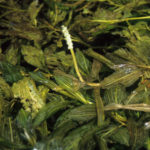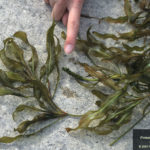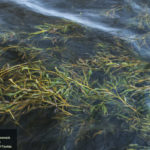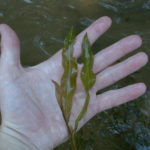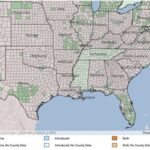Potamogeton illinoensis
Illustration courtesy of University of Florida/IFAS Center for Aquatic and Invasive Plants. Used with permission.
What is Illinois Pondweed?
Physical Characteristics
Leaves:
Submersed Leaves:
- Thin
- Elliptical- or sword-shaped
- Often somewhat curved
- 8 inches long & 1.77 inches wide
- Immobile
Floating Leaves:
- Leather texture
- Gradually become submersed
- Elliptical-shaped
- 7.5 inches long & 2.5 inches wide
- Rounded at base
- Often not present
Flowers:
- Immobile
- Oval-shaped
- 0.05 – 0.13 inches wide
- Small and green
- Flowers whorled along spike
- Spike 1 to 3 inches above water
Fruit:
- Oval-shaped
- 0.09 – 0.14 inches wide
- Flat on sides
- Top and bottom strongly developed
- Sides less developed than top or bottom
- Knob at base
- Gray-green to olive-brown when mature
Stem:
- Horizontal, underground stem
- Spotted with red
- Simple or branching
- Cylindrical
- 0.05-0.2 inches in diameter
- Thick and fleshy
Where Does it Grow?
USDA, NRCS. The PLANTS Database (http://plants.usda.gov). National Plant Data Team, Greensboro, NC 27401-4901 USA.
Illinois pondweed is a perennial plant that can be found in quiet or flowing alkaline waters of ponds, canals, lakes, streams, and rivers.
Pros and Cons of Illinois Pondweed
Illinois pondweed is utilized as food by ducks and some other types of wildlife. Submerged portions of all aquatic plants provide habitats for many micro and macro invertebrates. These invertebrates in turn are used as food by fish and other wildlife species (e.g. amphibians, reptiles, ducks, etc.). After aquatic plants die, their decomposition by bacteria and fungi provides food (called “detritus”) for many aquatic invertebrates.


